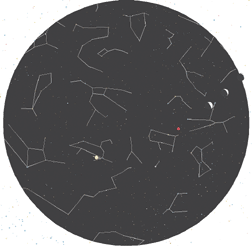The Awakening
Three animal constellations emerge with the coming of spring
As winter approaches its end, three big, springtime constellations climb out of hibernation in the eastern sky after dark. These are Ursa Major the great bear in the northeast; Leo the lion in the east; and Hydra the sea serpent in the southeast.
Ursa Major is a good starting point to find other stars and constellations in the sky. The body and tail of the bear make up what is known as the Big Dipper; the two outer stars of the Dipper’s bowl point north to Polaris, the North Star. Polaris is the lead star of the little bear, Ursa Minor.
Extending a line from the handle of the Big Dipper, leads to the star Arcturus in the constellation, Boötes. In Greek mythology, Arcturus is the bear-keeper.
The bright middle light in the Big Dipper’s handle is actually a double star, Alcor and Mizar. In ancient Rome, these stars were used as an eye test: If you could make out two separate stars your eyesight was good; if not, you had poor eyesight.
Leo the lion’s head and mane appear as an upside-down question mark called the sickle, with the bright spring star Regulus at the base. Extending from the question mark to the east are the lion’s body, legs and tail, the last marked by the white star Denebola — an Arabic name meaning tail of the lion.
Hydra is the largest constellation in the sky, stretching some 90 degrees along the southern horizon and taking four hours to rise completely. Also called the serpent of Lerna, Hydra was a beast with the body of a hound and 100 serpent heads. One of Hercules’s 12 tasks was to kill this monster, but each time he cut off a head, two grew back in its place.
Tidelog®
Illustration: © Copyright 1925 M.C. Escher/Cordon Art-Baarn-Holland; Graphics: © Copyright 2007 Pacific Publishers. Reprinted by permission from the Tidelog graphic almanac. Bound copies of the annual Tidelog for Chesapeake Bay are $14.95 ppd. from Pacific Publishers, Box 480, Bolinas, CA 94924. Phone 415-868-2909. Weather affects tides. This information is believed to be reliable but no guarantee of accuracy is made by Bay Weekly or Pacific Publishers. The actual layout of Tidelog differs from that used in Bay Weekly. Tidelog graphics are repositioned to reflect Bay Weekly’s distribution cycle.Tides are based on National Oceanic and Atmospheric Administration and are positioned to coincide with high and low tides of Tidelog.
